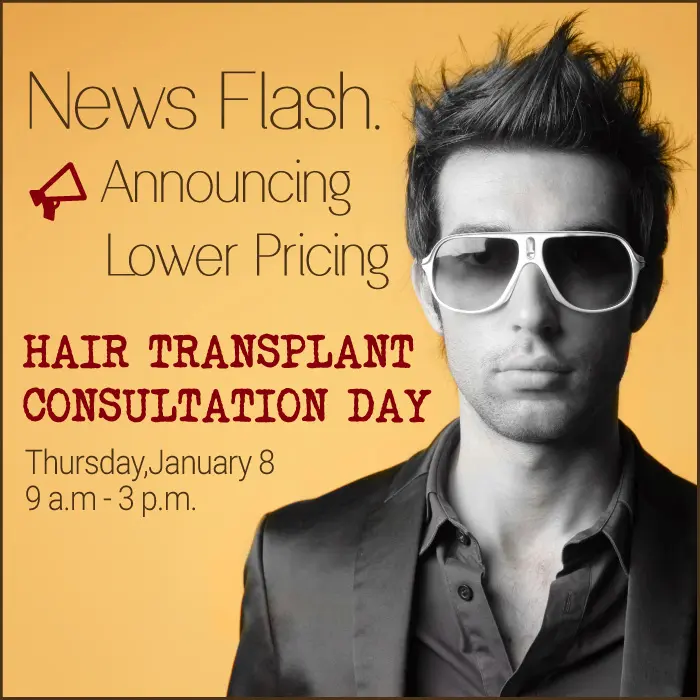Hair Transplant Expectations and Procedures
What the Procedure Is Like?
There are several steps involved in hair transplantation. First, the donor area (usually at the back of the scalp) is trimmed and the hair above it is taped to keep it up and away from the donor site. The donor site is then numbed with a local anesthetic.
Next, a strip of donor tissue is surgically removed, and the incision is sutured together.
Using a special microscope, the donor tissue is dissected, and individual follicular units (or micrografts) are prepared.
Local anesthesia is then administered to the recipient area of the scalp (trimming or shaving the hair here isn’t necessary).
Tiny incisions are made in the recipient area in an irregular pattern that mimics the way hair grows naturally. The micrografts are then carefully placed in these tiny incisions. They are placed in varying densities, with the smallest one- to two-hair grafts placed in the front of the hairline, and three- to four-hair grafts placed behind them.
Immediately after the transplant, you’ll have hundreds of tiny incisions with short hair stubble sticking out from the new grafts.
In two and a half to three months, the new hair will start growing in, and will grow at the normal rate of one-half to one inch per month thereafter.
What the Procedure Is Like?
There are several steps involved in hair transplantation. First, the donor area (usually at the back of the scalp) is trimmed and the hair above it is taped to keep it up and away from the donor site. The donor site is then numbed with a local anesthetic.
Next, a strip of donor tissue is surgically removed, and the incision is sutured together.
Using a special microscope, the donor tissue is dissected, and individual follicular units (or micrografts) are prepared.
Local anesthesia is then administered to the recipient area of the scalp (trimming or shaving the hair here isn’t necessary).
Tiny incisions are made in the recipient area in an irregular pattern that mimics the way hair grows naturally. The micrografts are then carefully placed in these tiny incisions. They are placed in varying densities, with the smallest one- to two-hair grafts placed in the front of the hairline, and three- to four-hair grafts placed behind them.
Immediately after the transplant, you’ll have hundreds of tiny incisions with short hair stubble sticking out from the new grafts.
In two and a half to three months, the new hair will start growing in, and will grow at the normal rate of one-half to one inch per month thereafter.
How to Prepare for Surgery
While each patient is given a comprehensive list of pre-operative instructions to ensure the best possible results, here’s an overview of what’s necessary to prepare for hair restoration surgery:
- For 10 days prior to your procedure, don’t take aspirin or vitamin E, gingko biloba or any multivitamins (since they contain vitamin E).
- For three days prior to your procedure, do not take anti-inflammatories (e.g., ibuprofen) and avoid drinking alcohol. You many take acetaminophen (Tylenol) instead of aspirin or ibuprofen if you need something for pain.
- Do not get a sunburn for three days prior to your procedure (or ever!).
- Stop using minoxidil (Rogaine®) and/or Propecia® three days before your procedure.
- To help cover the donor site sutures, let the hair in the back of your head grow to at least one- half inch in length.
- Do not use hair conditioner for two to three days before your procedure.
- For best healing, do not smoke for at least one week prior to and two weeks after your procedure.
- Get a good night’s sleep the night before your procedure.
- Have a good breakfast – but no caffeine – on the morning of your procedure.
- Feel free to bring snacks, drinks, and any music on CDs or tapes that you’d like to listen to during your procedure.
Postoperative Instructions
We remove the sutures after 10 days and patients can resume their life as usual then. We provide a complete instruction list that patients must follow to reduce the risk of complications after hair transplantation. These instructions include:
- Keep with your head elevated on several pillows or in a recliner chair to prevent swelling during the first 48 hours. Place a towel under your head the first night.
- The first night, wear the elastic headband we provide to help prevent swelling. You can remove it the next morning.
- Do not bend over for the first 48 hours; instead, bend at the knees.
- No alcohol for the first 24 hours.
Cleaning the Scalp after Surgery
Your scalp will be cleaned before you leave the office on the day of your procedure. There’s often some slight bleeding from some graft sites during the first 24 hours; simply apply light pressure with a clean cloth or gauze.
You may gently clean your scalp on the second day by taking a bowl into the shower, filling it with a mixture of water and a mild (not medicated) shampoo, and gently pouring it over the top, sides and back of your scalp. Do not let the shower spray directly hit the graft sites. Refill the bowl with clean water to rinse off the shampoo, then gently pat dry. Do not use conditioner until the scabbing is gone.
Gentle combing is permitted on the third day, but do not comb directly over grafts. Allow hair to air dry (no blow drying).
Continue this routine daily for the first five days. After this, you may begin to lightly rub the graft area to help remove scabs or crusts, and shower normally. Do not pick at the scabs since this can cause the transplanted hair follicles to dislodge. Any remaining crusts after eight days should be gently rubbed off. Stop if there is any bleeding and wait two more days.
What Else to Expect
Swelling around the face and eyes is common after a hair transplant. People also complain about bruising and discoloration. The discoloration is just from the bruising resolving.
Numbness at the graft sites and above the suture line at the donor site is common and normal. It will take several weeks, occasionally several months, to resolve.
Transplanted hairs often will fall out as the scabs fall off at five to seven days. Don’t panic! These are only the hair shafts – the transplanted hair follicles remain in the scalp. In about two and a half to three months, the new hair shafts will begin to grow in a natural fashion, and they’ll continue to grow at the normal rate of a half-inch to one inch per month. In rare cases, it can take up to six to nine months for all the hairs to grow in.
To accelerate the growth of the new hairs, we recommend that male patients begin applying 5% minoxidil (extra-strength Rogaine®) once or twice a day starting the tenth day after the procedure. Female patients should use the 2% minoxidil solution (Rogaine® for Women). If the minoxidil causes scalp redness, stop using it for one week, then resume once every other day. Once the hairs are growing in (at about three months post-procedure), the minoxidil can be stopped and the transplanted hairs will continue to grow. The occasional patient is sensitive to minoxidil (chest palpitations, lightheadedness, scalp itching), in which case it should be stopped.
As new hairs emerge from the scalp, occasionally there will be a few acne-like pimples. If this happens, apply warm, moist soaks and antibiotic ointment several times a day for three days. If it doesn’t resolve, please call the office.
Possible Risks and Side Effects
There are risks involved in any surgical procedure or treatment, and we provide every opportunity for you to ask questions to fully understand the possible risks and side effects of hair restoration surgery. While rare, these are the possible events or complications that may occur:
Scarring: Every time an incision is made in the human body, a scar will occur, although every effort will be made to make the scar as inconspicuous as possible. Superficial crusting, pinkness or redness of the incision area may occur, but these effects are usually temporary. Rarely, some area of skin around the suture edges may be lost and this will cause deep crusting which will take longer to heal. A stretched, widened scar is possible, as is a thickened or raised scar (hypertrophic/keloid). Significant scarring is more likely to occur in people who have had a history of the above type of scarring, or who have had previous transplants taken from the donor area.
Anesthesia Reactions: Local anesthetics (lidocaine, bupivacaine) with adrenaline (epinephrine) may have effects on many of the body’s organ systems, including the heart. Such effects may include allergic reactions, irregular heartbeats or, in unusual circumstances, heart attack. Such risks are uncommon with surgical procedures performed under local anesthesia. Patients on the type of heart or blood pressure medication called beta blockers may be particularly sensitive to epinephrine. Some patients may experience a temporary lightheaded episode as a nervous reaction to injections. This reaction may cause a drop in blood pressure and lead to fainting. This condition is easily and relatively quickly treated. If you are on any heart or blood pressure medication, you must inform Contour prior to surgery.
Allergic Reactions: There may be unusual, unexpected or allergic responses to drugs, medications, suture materials or foods prescribed or used during the surgical procedure. It’s important for Contour to be informed of any problem that you or a member of your family have had with reactions to drugs, as well as what medications you have taken in the past six months, including over-the-counter drugs (especially aspirin) and street drugs.
Folliculitis: This is an uncommon problem in which hair follicles become infected with bacteria. If it occurs, it’s usually in the postoperative period. Symptoms include redness around the grafts, pustules around emerging hairs, and itching. There may be some associated loss of hair in the involved follicles but, since the problem is localized to individual hair follicles, the loss is rarely significant from a cosmetic standpoint. Treatment consists of oral antibiotics that may be given for an extended period.
Hair Loss: There may be temporary hair loss in the back of the scalp surrounding where the donor strip was removed. This hair generally will grow back. Less commonly, there may be permanent hair loss in the skin adjacent to the surgical incision. In the transplanted area, you may experience shedding of your existing hair following the surgery (a condition called telogen effluvium). If this hair is at or near the end of its normal life span, it may not return. Because genetic balding is a continuous process, you may continue to lose more hair over time. If this occurs, a subsequent hair transplant procedure may be desired.
Hair Texture Changes: When your new hair begins to grow, it may be more kinked or wavier than your original hair. Over time, the hair generally resumes its normal character, but it’s possible that hair texture changes may persist.
Failure of Transplanted Hair to Grow: As in all surgical procedures, results cannot be guaranteed. It’s possible that some or all of the transplanted hair may fail to grow. Every effort will be made to give you the maximum yield from your transplanted hair.
Numbness and Pain: Numbness of the scalp may occur due to necessary cutting of fine nerve fibers in the skin. This is expected to gradually disappear over several months, but it’s possible that all sensation may not return. Rarely, sensory nerve injury may occur, resulting in long-term or possibly permanent numbness and/or pain in the scalp.
Smoking: Smoking causes constriction of blood vessels and decreased blood flow to the scalp, mainly due to nicotine. The carbon monoxide in smoke decreases the oxygen-carrying capacity of the blood. These factors may contribute to poor wound healing after a hair transplant and can increase the chance of a wound infection and scarring. Smoking may also contribute to poor hair growth. The deleterious effects of smoking wear off slowly when one abstains, so smoking puts a person at risk of poor healing even after smoking is stopped for weeks or even months.





-1024x602.jpg)













